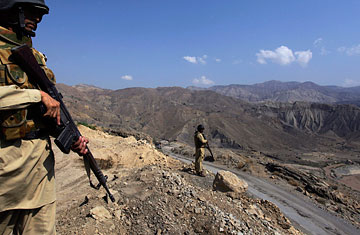
Pakistani paramilitary troops take position in Khajore Kut, part of the South Waziristan tribal region
It's no secret that for all its full-throated protests, the Pakistani government tolerates CIA drone attacks against Afghan insurgents and al-Qaeda targets based on its side of the border. But NATO helicopter attacks are another matter, especially when Pakistani troops die, as was the case last week when a coalition strike mistakenly killed three Pakistani soldiers.
Pakistan's response — the summary closure of a vital supply line for U.S. and NATO forces — could scarcely come at a worse time in the nine-year war. With more troops on the ground than ever before and clearing operations at full tilt across much of the southern battle zone, the move threatens to complicate the inflow of critical resources needed to keep the military machine humming, and convoys idled by the bottlenecks have become highly vulnerable to Taliban attack. It's also a sharp reminder of a fickle partnership whose strategic interests clash in the Afghan theater.
Washington and Islamabad are nominally united in their fight against Islamist militants in Pakistan and Afghanistan. After much foot-dragging, Pakistan in the past year has waged an aggressive campaign against a homegrown insurgency that has spilled from its tribal areas into its big cities, where suicide bombings and targeted killings have surged. Nevertheless, critics say the Pakistani army has been reluctant to move against militant groups like the Afghan Taliban and the allied Haqqani network, which have bases in Pakistan but are focused on Afghanistan because they want to preserve the Afghan groups as proxies once the U.S. withdraws from that country.
As popular support in the U.S. for the fighting dwindles, the Obama Administration has been hard-pressed to show compelling results ahead of the year-end White House war review. In the face of that, the Pentagon has chosen to ramp up drone attacks in Pakistan. Over the past five weeks, more than 20 have taken place. In recent days, this push escalated with a series of helicopter strikes on militant hideouts — and then a fatal mistake. NATO claims the chopper that killed the Pakistani soldiers received ground fire upon entering Pakistani airspace and shot back in defense, while Islamabad insists that the aircraft shouldn't have been there in the first place. An apology has been made, and an investigation launched. The question now is: What's next?
U.S. officials are hustling behind the scenes to avoid a meltdown with Pakistan that could seriously hamstring the counterinsurgency effort. Some 80% of NATO's nonlethal supplies are transported over Pakistani territory, entering Afghanistan through two border posts: Torkham Gate, near the mouth of the Khyber Pass, which Islamabad has shut down; and Chaman, in the southeast of the country, which remains open. But the impasse has stranded hundreds of trucks bearing critical fuel, military vehicles and food for international forces (which number more than 150,000), leaving the vehicles vulnerable to sabotage. A day after the government's decision, dozens of fuel tankers were set ablaze by unidentified militants. On Monday, another score of NATO tankers were set ablaze by Molotov cocktails near Islamabad, apparently by Taliban forces.
Indeed, even when the border is open, the eastern supply line is regularly attacked by militants, and the growing bottleneck of trucks offers a ripe target that Pakistani security forces have in recent years had a hard time protecting. Around the city of Peshawar alone, scores of trucks have been destroyed in various rocket attacks. Meanwhile, the northern supply route that passes through Central Asian countries is no longer the secure safety valve it once was. Hijackings and gun battles are more commonplace today along some stretches of roads. Although traffic has increased threefold since the Central Asian route was inaugurated, it takes longer and costs more than twice as much as passage through Pakistan's border, according to the U.S. Defense Department.
For the time being, U.S. military officials say they are not too worried. "Pakistan's closing the border is a visceral reaction to what is still a confused situation," says a senior officer who has commanded forces in Afghanistan, adding that he expects it to be back open in a few days. In the meantime, he went on, the military is streaming more traffic through the northern route. According to the chairman of the U.S. Joint Chiefs of Staff, Navy Admiral Mike Mullen, the border closure has not yet had any significant impact on military operations, and he's hopeful the rift with Pakistan will be resolved shortly.
To preserve face, some analysts reckon that Pakistan will delay reopening Torkham Gate until at least later this week, when officials will meet with U.S. representatives. They point to the fact that the smaller Chaman crossing is still open, a sign that Islamabad doesn't want to squeeze too hard. Pakistan also receives nearly $2 billion in military aid each year from Washington and can ill afford to hold out for long. What's more, many of the private trucking companies ferrying NATO supplies are controlled by former Pakistani generals, meaning tens of millions of dollars in profits are at stake. Says the senior U.S. officer: "It's in Pakistan's best interest not to let us develop those [northern supply] systems too extensively."
Yet the continued onslaught of American drone attacks since the border spat began could pose a problem. On Saturday, two more strikes reportedly killed eight militants in separate sites in North Waziristan, the insurgent-laden tribal region the Pakistani military has opted to leave alone. While Pakistan has provided intelligence in support of drone strikes, the popular backlash has been consistently fierce, as the attacks are seen as an affront to national pride, deepening already strong anti-American currents across the country.
